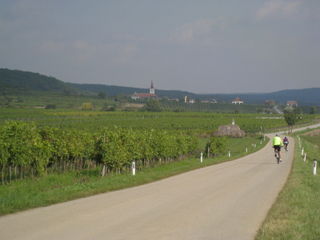Well, in the case of an Austrian wine that's poised to become a darling of trend-seeking Americans, a whole lotta baggage.
ZWEIGELT is a bright, lively, graceful, delicious red wine that had the misfortune to be named for the man who developed the grape variety in 1922 in Klosterneuburg, Austria. Pronounced TSVYE-gelt, the word lacks the easy pronunciation of, say, Chardonnay, and the sex appeal of the melodic wines that end in vowels, like Chianti and Rioja.
(Grüner Veltliner is probably Austria’s best-known wine export. I’m convinced that the difficulty in pronouncing that mouthful –basically GROO-ner FEHLT-lee-ner -- has left much of the drinking public ignorant of its charms.) www.thenibble.com/reviews/main/wine/gruner-veltliner.asp
 A cross of Blaufränkisch (another word that just trips off the tongue) and St. Laurent, Zweigelt is now
Austria’s most widely planted red grape. It combines the fruity character of Blaufränkisch and the structure and body of St. Laurent, which is a cousin of Pinot Noir. It is grown primarily in Burgenland, along Austria’s eastern borders with Hungary and Slovakia, and in Niederösterreich (Lower Austria), in northeastern Austria along the Czech Republic and Slovakia borders. The vineyards of Lower Austria are laced with an extensive system of bike routes. I took this photo during a recent bike tour of the region.
A cross of Blaufränkisch (another word that just trips off the tongue) and St. Laurent, Zweigelt is now
Austria’s most widely planted red grape. It combines the fruity character of Blaufränkisch and the structure and body of St. Laurent, which is a cousin of Pinot Noir. It is grown primarily in Burgenland, along Austria’s eastern borders with Hungary and Slovakia, and in Niederösterreich (Lower Austria), in northeastern Austria along the Czech Republic and Slovakia borders. The vineyards of Lower Austria are laced with an extensive system of bike routes. I took this photo during a recent bike tour of the region.
In Austria, Zweigelt is hugely popular…prized for its freshness, its attractive spice and floral notes, and its food-friendly nature. Its price is a lure, too. During our recent month-long vacation there, we rarely paid more than $10 for a bottle, retail. Here in the U.S., most of the available wines are in the $13 to $16 range, with a few older Reserves fetching more.
A Wall Street Journal article earlier this year swooned over Zweigelt, saying the wines “looked dark and smelled dark and spicy, bursting with blueberry and blackberry fruits as well as some juicy plums….In the mouth, though, they were surprising light bodied.” The article, by columnists Dorothy J. Gaiter and John Brecher, also tossed around words like “vibrant,” “verve,” “plenty of character but not challenging.”
A 2007 New York Times article was similarly taken with Zweigelt’s charms: “Lively and refreshing, with cherry, mineral and spice flavors, energizing rather than fatiguing.”
Energizing rather than fatiguing. That's my kind of wine. Anyone who's ever felt lethargic after dinner, or awakened in the morning with dragon-mouth and a throbbing head, can understand the appeal.
Zweigelt is showing up more and more often in U.S. wine shops and on wine lists. At present, it’s a trickle as opposed to a flood. But given the current wobbly economy, and our insatiable appetite for something different and delicious, I see no reason why value-priced, super-drinkable Zweigelt won’t be the next big rage.
 If you live in a big city, you can check local wine shops for names like Hillinger, Anita und Hans Nittnaus, Walter Buchegger, and Steininger. If you’re shopping on-line, consider Snooth, Wine-Searcher, Corkd or WineLog.
If you live in a big city, you can check local wine shops for names like Hillinger, Anita und Hans Nittnaus, Walter Buchegger, and Steininger. If you’re shopping on-line, consider Snooth, Wine-Searcher, Corkd or WineLog.
Zweigelt is an ideal choice to partner the Thanksgiving turkey.


Comments